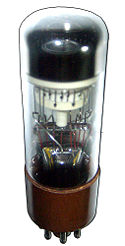
Back Decatró Catalan Zählröhre German Decatrón Spanish Dekatron French Dekatron Hungarian Դեկատրոն Armenian Dekatron ID Dekatron Italian 計数放電管 Japanese 데카트론 (일렉트로닉스) Korean
This article includes a list of general references, but it lacks sufficient corresponding inline citations. (September 2009) |
 Octal-base dekatron | |
| Working principle | Cold cathode |
|---|---|
| Inventor | 1949[1] |
| Computer memory and data storage types |
|---|
| Volatile |
| Non-volatile |
In electronics, a Dekatron (or Decatron, or generically three-phase gas counting tube or glow-transfer counting tube or cold cathode tube) is a gas-filled decade counting tube. Dekatrons were used in computers, calculators, and other counting-related products during the 1950s and 1960s. "Dekatron" was the brand name used by Ericsson Telephones Limited (ETL), of Beeston, Nottingham (not to be confused with the Swedish TelefonAB Ericsson of Stockholm) and has since become a generic trademark. The device was invented by John Reginald Acton, with the patent assigned to Ericsson.[2]
The dekatron was useful for computing, calculating, and frequency-dividing purposes because one complete revolution of the neon dot in a dekatron usually means 10 pulses on the guide electrode(s), and a signal can be derived from one of the cathodes in a dekatron to send a pulse, possibly for another counting stage. Dekatrons usually have a maximum input frequency in the high kilohertz (kHz) range – 100 kHz is fast, 1 MHz is around the maximum possible. These frequencies are obtained in hydrogen-filled fast dekatrons. Dekatrons filled with inert gas are inherently more stable and have a longer life, but their counting frequency is limited to 10 kHz (1–2 kHz is more common).
- ^ "Computer Resurrection Issue 61". ComputerConservationSociety.org. Retrieved 2020-12-20.
- ^ Dekatron patent US2651004A